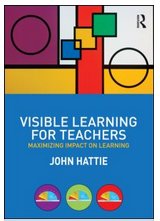Teachers are professionals. I believe that but I suspect a lot of people don’t because I often hear people talk about teachers in a way they would never talk about dentists, doctors, lawyers, or chefs. But you know what, I think it is largely the fault of teachers themselves. Do you need proof? OK, look at the list below and put the teaching factors into one of two categories: very effective, and not really effective. Then take a look at the bottom of this post to see how you did.
- whole language
- ability grouping
- homework
- using television
- feedback
- teaching strategies
- peer tutoring
- repeated reading programs
As it turns out, the top four have been found to be not very effective at all and are actually among the least effective of 150 interventions/approaches that have been examined in the now-up-to-900 -plus-study meta-analysis that John Hattie has been engaged in for the last few years. The bottom four are among the most effective. I think teachers and non-teachers alike have difficulty with this task and even teachers who managed to complete the task successfully probably didn’t do so with confidence. That is a problem. Data on successful and unsuccessful approaches and techniques are not widely known and/or accepted it seems. John Hattie is trying to change that. In his wonderful new book, Visible Learning for Teachers, he not only ranks 150 interventions/approaches in terms of effect size, but he interprets the key results, showing how they affect the business of learning.
In this book, he talks about the implications of these research results on teaching. He is not suggesting some new technique for teaching. Instead it is a new mindset that he is recommending, actually a series of mindsets that have the power to make teachers and teaching much more effective and much more professional. It is in places buckets of icy water aimed at the faces of teachers themselves. Yet he carefully stresses the importance of the role of teachers in improving education and in doing so empowers teachers–or rather encourages teachers to empower themselves–in a way no book or program I’ve ever experienced has. The main part of the book looks at all aspects of teaching, from preparing and starting the lesson, to giving feedback and ending the lesson. The emphasis is on learning, not teaching, however. And that is one of the mindset changes he advocates. Everything a teacher does must come with questions: Did this help my students learn? Did it help everyone? How much? Teachers need to shift their thinking away from the day-to-day tasks of getting the job done, toward a belief that their fundamental overriding task is to evaluate the effect of their teaching on students’ learning and achievement. Teachers also need to believe that they are the change agents above all others. Success or failure in student learning is the result of what teachers do (or do not do). Other environmental/situational factors are what they are. It is up to each teacher to work with what they have and maximize the effect they have. This is an important shift.
In my job as a teacher trainer I often get sucked into a trap Mr. Hattie warns about. Teachers always want to talk about teaching rather than learning. It is important to keep the eyes focused on learning and see everything through that lens. Everything at the school–the classroom, the staff room, the administration–must all be focused on maximizing learning. Assessment is not just for the students; assessment is how teachers know what their impact is, how administrators know what is happening, how parents and the public can see what is happening. Knowing the effects of education/interventions/policies/approaches, discussing the effects, and displaying the effects are how to improve the current situation. This will require mindset changes for learners, their parents, teachers and administrators. But the beauty of this system is that there is a clear purpose and it is informed by data. That is something to rally around.
The research in the book provides merely a rough guide, however. The studies are from a wide range of subjects and schools and countries and you will likely find yourself wishing that it was more specifically aimed at your particular discipline. There is plenty of room to tweak things for your own specific situation. But the data are a good challenge to anyone wedded to a certain approach for no other reason than habit. Some approaches have been clearly shown to be better and need to be given more prominence in any program. Everything is up for discussion, however, and through carefully monitoring learning and having an open dialogue better classes, better courses, better schools and better, more professional teachers can be realized.
I highly recommend this book. It is an important book. It will make you think and re-assess your position on the way you approach your craft. It is a book to be read by teachers, discussed by teachers, and referred to when making decisions on teaching and policy. This book has the power to make us teachers stop whining and making excuses. We are the agents of change, data-informed, positive change.
According to Dr. Hattie’s calculations, anything intervention with an effect size of 0.40 or higher is very positive and has thus demonstrated a benefit to learning. Here are the effect sizes for the approaches/interventions listed in the beginning of this post.
- feedback (0.75)
- repeated reading programs (0.67)
- teaching strategies (0.62)
- peer tutoring (0.55)
- homework (0.29)
- ability grouping (0.12)
- whole language (0.06)
- using television (-0.18)

